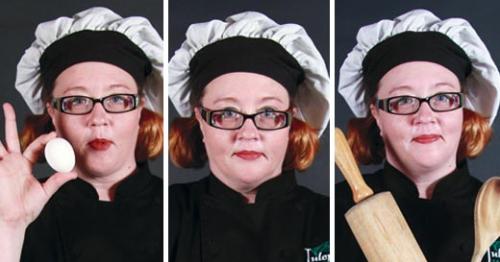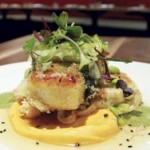Like a duck: calm and serene on the surface of the lake, but paddling furiously underneath. When things go well, that’s what banquet service (think a plated dinner at a wedding) is like.
I worked a wedding last weekend. Now, even from a kitchen staff standpoint, this was a very well organized and executed service. (Believe me, I have been caught up in a few catering nightmares, but this was not one of those.) But I’m still delighted when guests say things like, “Everything was wonderful! The food was delicious!”
People often say, “I’d love to peek back there and see what goes on in the kitchen tent.” Well, maybe you would. You might find it tedious. On the other hand, you might find it fascinating.
For a large (more than 125 guests) outdoor wedding, the meal is usually served under a massive tent, which is probably erected one or two days before the event. Within the tent are all the rented tables, rented linens, rented chargers (this is the fancy metallic “plate” at your place setting that cradles the actual plate your meal is served on), rented glassware, flatware, chairs, chair covers, flower arrangements, party favors, etc. There’s a cake table in the corner with the wedding cake. And part of the massive tent is sectioned off for the temporary kitchen.
So, what’s involved in a temporary kitchen? We need somewhere to keep things cold and somewhere else to keep things hot. Sometimes a rented refrigerated truck is your cold spot, and then sometimes it’s just a series of massive insulated plastic coolers, full of ice, with the greens and the salad components and desserts within. Hot stuff is kept in “hot boxes” — big metal rolling cabinets with multiple slots that can hold sheet pans. Fancy hot boxes are wired for electricity and can maintain the necessary temps on their own. But it’s rare that a temporary set-up has the juice to handle the electricity these things pull, so often it’s just the metal boxes with Sterno pots aflame inside.
So, we’ve brought the food to the venue. We may need to heat some of it up over propane burners. Then it goes into covered pans that are inserted into the hot boxes. Maybe we have to set up a charcoal or gas grill outside (you can’t grill under the tent, so pray for no rain!) to grill steaks or other proteins.
Normally for hors d’oeuvres, salads and desserts, a couple hundred plates are laid out on empty folding tables and everybody grabs one component (“I’ll do the lettuce, you do the sunflower seeds and you do the micro-greens”) and in a flurry of activity you get them all plated in the least possible amount of time. Then the servers come in and line up with their trays and it’s “I need nine!” “I need six!” “I need seven plus one with no shrimp!” We load ‘em up and send them into the dining part of the tent.
Middle and entrée courses are plated assembly-line style. Folding tables are set a-row with a double line of chafing dishes down the middle. At one end are the empty plates. Kitchen staff stand on each side, utensils ready. When word comes that it’s time to start plating, the guy standing nearest the plates grabs one and puts his component (say, mashed potatoes or grits) in the spot on the plate previously demonstrated by Chef, then pushes the plate forward to the next person, who might add the protein, passing the plate along to the next person, who’ll add vegetables, to the next guy, who ladles the sauce on top, to the next one, who places the perfect amount of garnish atop the dish, to the next guy, who wipes the edges of the plate clean of any drips or drops, to the expeditor, who loads up the oval trays the servers use to transport the meals to the dining room.
The head chef is conducting a symphony here: time to bring in the brass, bring in the strings — but quietly: “That’s too much grits on the plates, back off!” “Pick up the pace a little!” “Slow down, we’re backing up at the pass!” And everyone’s just trying, at this point, to do the best job they can and not make it difficult for someone further down the line.
When all goes right, plates sail serenely out into the dining room, and no guest ever suspects that we are back there, paddling furiously under the water. Like ducks.
Marsha Lynch has worked at many Louisville independent restaurants including Limestone, Jack Fry’s, Jarfi’s, L&N Wine Bar and Bistro, and Café Lou Lou.




